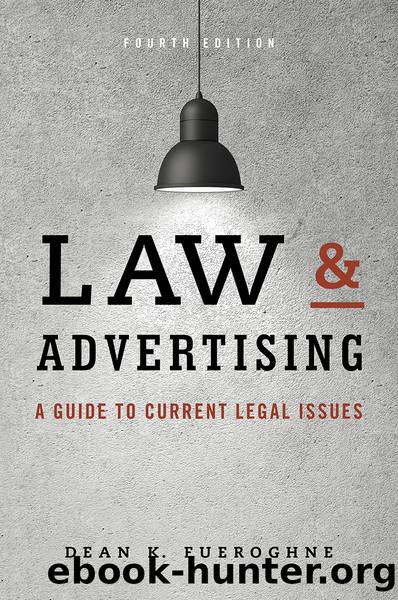Law & Advertising by Fueroghne Dean K.;

Author:Fueroghne, Dean K.;
Language: eng
Format: epub
ISBN: 9781442244894
Publisher: Rowman & Littlefield Publishers
Published: 2017-01-29T00:00:00+00:00
Labeling and Its Relationship to the Lanham Act
While most of the cases that weâve looked at here have arisen as a result of problems with advertising, the Lanham Act also applies to labeling. In fact, the statute specifically provides:
Any person who shall affix, apply, or annex, or use in connection with any goods or services, or any container or containers for goods, a false designation of origin, or any false description or representation, including words or symbols tending falsely to describe or represent the same, and shall cause such goods or services to enter into commerce, and any person who shall with knowledge of the falsity of such designation of origin or description or representation cause or procure the same to be transported or used in commerce or deliver the same to any carrier to be transported or used, shall be liable to a civil action by any person doing business in the locality falsely indicated as that of origin or in the region in which said locality is situated, or by any person who believes that he is or is likely to be damaged by the use of any such false description or representation.
A Regular Example Keeping this in mind, what if you wanted to make reference to a competitorâs trademark on your own product label? You can, if your label reference is truthful, according to a decision in C. D. Searle & Co. v. Hudson Pharmaceutical Corp., 715 F.2d 837 (3rd Cir. 1983).
The case was brought under Section 43(a) of the Lanham Act and involved a vegetable laxative marketed and sold by two competitive pharmaceutical firms. Since 1934 Searle marketed a laxative product containing psyllium hydrophilic mucilloid using the registered trademark METAMUCIL. In 1964 Hudson Pharmaceutical Corp. marketed a laxative containing the same psyllium hydrophilic mucilloid, under the registered trademark name REGACILIUM.
Hudson had developed a comparative advertising campaign that ran for many years, not only in trade publications but also in point-of-purchase materials. Since 1972 Hudson had included in its comparative ads the claim that REGACILIUM is âEquivalent to METAMUCIL.â
Until 1980 both of these companiesâ competitive products were packaged very differently. In that year, however, Hudson changed its productâs packaging to resemble the METAMUCIL packaging. In addition to the ads, Hudsonâs new package label contained the statement Hudson had long used in trade catalogs and point-of-purchase advertising: âEquivalent to METAMUCIL.â
The new packaging with its comparative statement brought on the lawsuit. Searle sued Hudson to halt any mention of METAMUCIL on the REGACILIUM container. The court held that Hudson could not make further reference to METAMUCIL on the REGACILIUM container, stating:
Unless the defendantâs container is changed such that âMETAMUCIâ appears in type no larger than the word âEquivalentâ and in green letters on the white background. Defendant shall place an asterisk next to the METAMUCIL mark and shall state adjacent to said mark the statement âa product of G.D. Searle, not a Hudson product.â
It was âproper for Hudson, on its REGACILIUM container, to truthfully characterize REGACILIUM as âEquivalent to METAMUCIL.
Download
This site does not store any files on its server. We only index and link to content provided by other sites. Please contact the content providers to delete copyright contents if any and email us, we'll remove relevant links or contents immediately.
You Don't Own Me by Orly Lobel(1405)
Intellectual Property Strategy by John Palfrey(1383)
Hello, My Name is Awesome by Alexandra Watkins(1324)
Without Copyrights by Spoo Robert(1306)
Profit From Your Idea: How to Make Smart Licensing Deals by Attorney Richard Stim(1292)
The Trademark Guide by Lee Wilson(1200)
Democracy of Sound by Alex Sayf Cummings(1185)
A Triumph of Genius: Edwin Land, Polaroid, and the Kodak Patent War by Ronald K. Fierstein(1169)
The Copywriter's Handbook by Robert W. Bly(1134)
Kafka's Last Trial by Benjamin Balint(1131)
World War 3.0 by Ken Auletta(1119)
Data Protection: A Practical Guide to UK and EU Law by Carey Peter(1105)
What They'll Never Tell You About the Music Business by Peter M. Thall(1063)
BVR's Guide to Intellectual Property Valuation by Michael Pellegrino(1048)
The Tech Contracts Handbook: Software Licenses and Technology Services Agreements for Lawyers and Businesspeople by David Tollen(1045)
Mass Media Law by Pember Don & Pember Don(1040)
Hello, My Name Is Awesome: How to Create Brand Names That Stick (BK Business) by Alexandra Watkins(1032)
Patent It Yourself: Your Step-by-Step Guide to Filing at the U.S. Patent Office by Pressman David Attorney(1029)
The New Censorship: Inside the Global Battle for Media Freedom by Joel Simon(1012)
